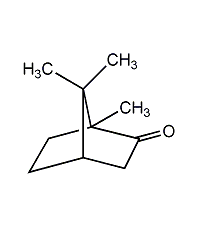
Structural formula
| Business number | 01KV |
|---|---|
| Molecular formula | C10H16O |
| Molecular weight | 152.24 |
| label |
2-camphenone, DL-camphor, DL-Camphor, DL-2-Bornanone, moth repellent, preservative, Functional Materials, Plasticizer |
Numbering system
CAS number:76-22-2
MDL number:MFCD00074738
EINECS number:200-945-0
RTECS number:EX1260000
BRN number:2042745
PubChem number:24852306
Physical property data
1. Characteristics: Colorless to white translucent lumps or powder with camphor wood smell. [1]
2. Melting point (℃): 174~180[2]
3. Boiling point (℃) : 204 (sublimation) [3]
4. Relative density (water = 1): 0.99 (25℃) [4]
5. Relative vapor density (air=1): 5.24[5]
6. Saturated vapor pressure (kPa): 0.024 (20℃) [6]
7. Heat of combustion (kJ/mol): -5898.0[7]
8. Critical pressure (MPa) : 2.99[8]
9. Octanol/water partition coefficient: 2.38[9]
10. Flash point (℃): 65.6 (CC) [10]
11. Ignition temperature (℃): 466[11]
12. Explosion upper limit (%): 3.5[12]
13. Explosion lower limit (%): 0.6[13]
14. Solubility: Slightly soluble in water, soluble in most organic solvents such as ethanol, ether, chloroform, carbon disulfide, oils, and solvent naphtha. [14]
15. Refractive index: 1.5462
16. Heat of evaporation (KJ/mol, b.p.): 59.54
17. Heat of fusion (KJ/mol): 6.85
18. Solubility (%, water): 0.01
Toxicological data
1. Acute toxicity[15]
LD50: 70mg/kg (rat dermal); 1310mg/kg (mouse dermal) Oral)
LC50: 500mg/m3 (rat inhalation)
2. Irritation No information available p>
3. Mutagenicity [16] Sister chromatid exchange: mice were given 80 mg/kg intraperitoneally.
Ecological data
1. Ecotoxicity[17] LC50: 110mg/L (96h) (fathead minnow, static); 35~50mg/L (48~96h) (Zebrafish)
2. Biodegradability [18] MITI-I test, initial concentration 100ppm, sludge concentration 30ppm, after 4 weeks Degraded 94%.
3. Non-biodegradability[19] In the air, when the hydroxyl radical concentration is 5.00×105 pcs/cm3, the degradation half-life is 1.6d (theoretical).
4. Bioconcentration[20] BCF: 38 (theoretical)
Molecular structure data
1. MountDistillate. The distillate is sent to the xylene recovery tower for fractionation to recover xylene and camphene for reuse. The molten camphor at the bottom of the tower continuously enters the sublimation pot and is heated to 210°C using an oil bath. The camphor continues to sublimate and is cooled into the sublimation chamber to become medicinal camphor. The non-condensable gas recovers the camphor through a water spray device and is discharged into the atmosphere.
Purpose
1. Camphor has a wide range of uses. It is used in medicine as a nerve stimulant and local stimulant, and can be used in cooling and heat-reducing drugs such as Ten Dishui and Rendan. Camphor is also used for antiseptic and insect-proof purposes. It can also be used to prepare food flavors such as mint, white lemon and nuts, as well as daily flavors such as toilet water and daily cosmetics. In addition, camphor is widely used in celluloid and photographic film, as a stabilizer in the manufacture of smokeless gunpowder, and as a raw material for the manufacture of sodium camphor sulfonate. Used as a plasticizer for nitrocellulose, cellulose ethers and cellulose esters. It is also used as a moth repellent, preservative, and in the manufacture of gunpowder, medicine, spices, fireworks, etc.
2. Used as incense and medicine. It is used medicinally as an antiseptic, local anesthetic, carminative, cardiotonic, etc. Used in cosmetics for nail polish. Used as a plasticizer for nitrocellulose. It is also used as a food flavoring, mainly used in the preparation of mint essence and essential oil imitations. It is also used in the production of rubber, electrical insulation materials, aircraft parts, etc. It is also used in the arms industry to produce explosion stabilizers for smokeless gunpowder, and in the pesticide industry to produce insecticides and preservatives.
3. Camphor can be used as a plasticizer for cellulose esters, ethers, and polyvinyl chloride.
4. Used in the manufacture of celluloid, chemical paints, photographic films, explosives, spices, insecticides, medicines, etc. [26]



 微信扫一扫打赏
微信扫一扫打赏
